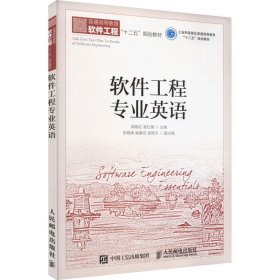
软件工程专业英语
实拍图,高温消毒后发出,下午四点之前的订单一般当天发货
¥ 8.07 2.2折 ¥ 36 九品
仅1件
天津宝坻
认证卖家担保交易快速发货售后保障
作者郭晓红、谢红薇 著
出版社人民邮电出版社
出版时间2021-06
版次8
装帧平装
上书时间2024-11-06
- 在售商品 暂无
- 平均发货时间 10小时
- 好评率 暂无
- 最新上架
商品详情
- 品相描述:九品
图书标准信息
- 作者 郭晓红、谢红薇 著
- 出版社 人民邮电出版社
- 出版时间 2021-06
- 版次 8
- ISBN 9787115418982
- 定价 36.00元
- 装帧 平装
- 开本 16开
- 页数 204页
- 字数 241千字
- 正文语种 简体中文
- 丛书 普通高等教育软件工程“十二五”规划教材
- 【内容简介】
- 本书以计算机发展的新热点为主要内容,介绍了移动计算机、软件工程及其再工程、主存数据库、网络与安全、人工智能、大数据、移动互联网、物联网等知识。本书力求使得学习者在学习计算机专业英语的同时也能学到计算机发展的前沿知识,使得学习者的外语水平和专业知识共同得到提高,为今后的计算机职业生涯打下一个良好的基础。
- 【作者简介】
- 郭晓红,太原理工大学计算机学院副教授,长期从事计算机科学与技术、软件工程相关专业的专业课程教学和科研工作,具有丰富的教学(双语教学)与实践经验。
- 【目录】
-
Chapter 1 Mobile Computers1
Competencies 1
1.1 An Overview of Mobile Computers 2
1.1.1 Types of Mobile Computers 2
1.1.2 Features of Mobile Computers 4
1.1.3 CPU Architectures of Mobile
Computers 5
1.1.4 Mobile Operating Systems 6
1.1.5 Mobile Apps 8
1.2 Smartphones 9
1.2.1 Functions 9
1.2.2 iPhone 11
1.2.3 Android Phones 14
1.3 Android Operating System 17
1.3.1 The Origin of Android 18
1.3.2 Android User Interface 19
1.3.3 Android Architecture 20
1.3.4 Google Play-Android App
Store 21
Concepts 23
Terms 24
Reading 1 Future Developments for
Smartphones 27
Reading 2 Smartphones and Poor
Sight 27
Reading 3 Android Software
Development Tools 28
Multiple Choice 30
True False Questions 32
Fill in the Blanks 32
Reference 33
Chapter 2 Software
Reengineering 34
Competencies 34
2.1 Software Engineering 35
2.1.1 An Overview of Software
Engineering 35
2.1.2 Software Process Model 36
2.1.3 Phases of Software
Development 40
2.1.4 Methodology of Software
Development 42
2.2 Software Reengineering 42
2.2.1 Origin of Reengineering 43
2.2.2 A Software Reengineering
Model 44
2.2.3 Software Reengineering
Activities 46
2.3 Reverse Engineering 48
2.3.1 What is Reverse Engineering? 49
2.3.2 The Reverse Engineering
Process 49
2.3.3 Reverse Engineering to
Understand Processing 50
2.3.4 Reverse Engineering to
Understand Data 51
2.3.5 Reverse Engineering User
Interfaces 52
Concepts 52
Terms 53
Reading 1 Software 54
Reading 2 Computer Programming 55
Reading 3 Basic Application Software 57
Multiple Choice 58
True False Questions 60
Fill in the Blanks 61
References 61
Chapter 3 Main Memory
Databases 63
Competencies 63
3.1 An Overview of Main Memory
Databases 63
3.1.1 What is a Main Memory
Database? 64
3.1.2 The Differences between Main
Memory Databases and Disk
Resident Databases 64
3.1.3 Features of Main Memory
Databases 65
3.2 The Evolution of Main Memory
Database 65
3.3 The Key Technology of Main Memory
Databases 66
3.3.1 Performance and Data Structure 66
3.3.2 Commit Processing and Backup 68
3.3.3 Recovery and Concurrency 68
Concepts 70
Terms 70
Reading 1 Database Basics 71
Reading 2 Database Management 72
Reading 3 Database Models 73
Multiple Choice 76
True False Questions 78
Fill in the Blanks 78
References 79
Chapter 4 Networking and
Security 80
Competencies 80
4.1 LAN 80
4.1.1 Ethernet LAN 81
4.1.2 Packets-Data Transmission 82
4.1.3 Ethernet-Sending One Packet 82
4.1.4 Wi-Fi 83
4.1.5 A Summary of Ethernet Design 83
4.2 TCP IP 84
4.2.1 IP Address 84
4.2.2 Domain Names 85
4.2.3 Router 85
4.2.4 What does it Mean to be on the
Internet? 85
4.2.5 Ping 86
4.2.6 Traceroute 86
4.3 Security 87
4.3.1 Computer-A Castle 87
4.3.2 Password Attacks 87
4.3.3 Phishing Attacks 89
4.3.4 Malware Attacks 90
4.3.5 Safety Recap 92
Concepts 92
Terms 93
Reading 1 Networking 94
Reading 2 TCP IP 96
Multiple Choice 98
True False Questions 101
Fill in the Blanks 101
Reference 102
Chapter 5 Artificial Intelligence 103
Competencies 103
5.1 History 104
5.1.1 Precursors 104
5.1.2 The Birth of Artificial
Intelligence 105
5.1.3 AI's Golden Years and Its
Boom 105
5.2 Research Goals 107
5.2.1 The Short-term Goal 107
5.2.2 The Long-term Goals 107
5.3 Major Researches on AI 108
5.3.1 Deduction, Reasoning
and Problem Solving 108
5.3.2 Knowledge Representation 109
5.3.3 Automated Planning and
Scheduling 109
5.3.4 Machine Learning 110
5.3.5 Natural Language Processing 110
5.3.6 Robotics 110
5.3.7 AI Game 111
5.4 Applications of AI 112
5.4.1 Apple Watch Siri 112
5.4.2 Google Atlas5 113
5.4.3 ABB's YuMi 114
5.4.4 Leonardo's Robot 114
Concepts 115
Terms 116
Reading 1 Virtual Reality 118
Reading 2 Knowledge-Based (Expert)
System 119
Multiple Choice 119
True False Questions 121
Fill in the Blanks 122
References 123
Chapter 6 Big Data 124
Competencies 124
6.1 Big Data and its Properties 124
6.1.1 What is Big Data? 125
6.1.2 Four Dimensions of Big Data 125
6.2 Categories of Big Data 126
6.2.1 Data from the Physical World 127
6.2.2 Data from Human Activities 127
6.3 Big Value of Big Data 128
6.4 Jim Gray's Fourth Paradigm 130
6.5 Evolution of Data Management 131
6.6 Big Data Challenges 133
Concepts 134
Terms 134
Reading 1 How Hadoop can be
Used 137
Reading 2 A Multi-stage Filtering
Strategy for Audio
Retrieval 138
Reading 3 NSF Program: Exploiting
Parallelism and
Scalability 139
Multiple Choice 140
True False Questions 142
Fill in the Blanks 143
Reference 144
Chapter 7 Mobile Internet 145
Competencies 145
7.1 Overview 145
7.1.1 Development 146
7.1.2 Basic Concepts 147
7.1.3 Characteristics 148
7.2 Standards 150
7.3 Business Patterns 151
7.3.1 Mobile Social 151
7.3.2 Mobile Advertising 152
7.3.3 Mobile Location-based
Services 153
7.3.4 Mobile Search 153
7.4 Application Prospect 154
Concepts 155
Terms 156
Reading 1 Mobile Game 157
Reading 2 Mobile TV 158
Reading 3 Mobile E-commerce 159
Multiple Choice 160
True False Questions 162
Fili in the Blanks 162
References 163
Chapter 8 Internet of Things 164
Competencies 164
8.1 Definition of Internet of Things 165
8.1.1 Origin of the Concept of
"Internet of Things" 165
8.1.2 Common Definition of Internet
of Things 165
8.1.3 Development of the Internet of
Things 166
8.2 Technologies of Internet of Things 169
8.2.1 Wireless Sensor Network 169
8.2.2 Embedded System 172
8.2.3 RFID 176
8.2.4 Other Technologies 179
8.3 Applications of Internet of Things 181
8.3.1 Food 181
8.3.2 Health 181
8.3.3 Intelligent Home 183
Concepts 185
Terms 185
Reading 1 Classification of the
Internet of Things 188
Reading 2 The Architecture of the
Internet of Things 190
Reading 3 The Features of the Internet
of Things 191
Multiple Choice 191
True False Questions 193
Fill in the Blanks 194
References 195
点击展开
点击收起
相关推荐
— 没有更多了 —





















以下为对购买帮助不大的评价